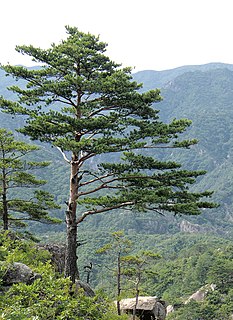
A pine is any conifer in the genus Pinus of the family Pinaceae. Pinus is the sole genus in the subfamily Pinoideae. The Plant List compiled by the Royal Botanic Gardens, Kew and Missouri Botanical Garden accepts 126 species names of pines as current, together with 35 unresolved species and many more synonyms. Pine may also refer to the lumber derived from pine trees; pine is one of the more extensively used types of wood used as lumber.

Toxicodendron is a genus of flowering plants in the sumac family, Anacardiaceae. It contains trees, shrubs and woody vines, including poison ivy, poison oak, and the lacquer tree. All members of the genus produce the skin-irritating oil urushiol, which can cause a severe allergic reaction. The generic name is derived from the Greek words τοξικός (toxikos), meaning "poison," and δένδρον (dendron), meaning "tree". The best known members of the genus in North America are poison ivy (T. radicans), practically ubiquitous throughout most of eastern North America, and western poison oak, similarly ubiquitous throughout much of the western part of the continent.

A banyan, also spelled "banian", is a fig that begins its life as an epiphyte, i.e. a plant that grows on another plant, when its seed germinates in a crack or crevice of a host tree or edifice. "Banyan" often specifically denominates Ficus benghalensis, which is the national tree of India, though the name has also been generalized to denominate all figs that share a common life cycle and used systematically in taxonomy to denominate the subgenus Urostigma.
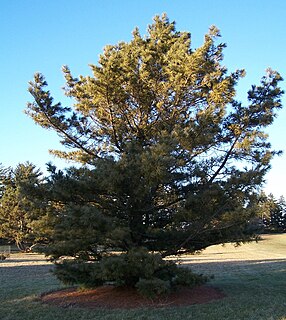
Pinus koraiensis is a species of pine known commonly as the Korean pine. It is native to eastern Asia: Korea, northeastern China, Mongolia, the temperate rainforests of the Russian Far East, and central Japan. In the north of its range, it grows at moderate elevations, typically 600 to 900 metres, whereas further south, it is a mountain tree, growing at 2,000 to 2,600 m elevation in Japan. Other common names include Chinese pinenut.

Ficus elastica, the rubber fig, rubber bush, rubber tree, rubber plant, or Indian rubber bush, Indian rubber tree, is a species of plant in the fig genus, native to eastern parts of South Asia and southeast Asia. It has become naturalized in Sri Lanka, the West Indies, and the US State of Florida.

Lathyrus japonicus is a legume native to temperate coastal areas of Asia, Europe, and North and South America.

Schefflera arboricola is a flowering plant in the family Araliaceae, native to Taiwan as well as Hainan. Its common name is dwarf umbrella tree, as it appears to be a smaller version of the umbrella tree, Schefflera actinophylla.

Banksia grandis, commonly known as bull banksia or giant banksia, is a species of common and distinctive tree in the south-west of Western Australia. The Noongar peoples know the tree as beera, biara, boongura, gwangia, pira or peera. It has a fire-resistant main stem with thick bark, pinnatisect leaves with triangular side-lobes, pale yellow flowers and elliptical follicles in a large cone.

Banksia condolleana, commonly known as the propeller banksia, is a species of shrub that is endemic to Western Australia. It has shiny green, deeply serrated leaves with triangular lobes and spikes of golden yellow flowers on short side branches.

Acacia decurrens, commonly known as black wattle or early green wattle, is a perennial tree or shrub native to eastern New South Wales, including Sydney, the Greater Blue Mountains Area, the Hunter Region, and south west to the Australian Capital Territory. It grows to a height of 2–15 m (7–50 ft) and it flowers from July to September.

Tsuga dumosa, commonly called the Himalayan hemlock or in Chinese, Yunnan tieshan, is a species of conifer native to the eastern Himalayas. It occurs in parts of Nepal, India,(Bhutan), Burma, Vietnam, and Tibet province, China. Within its native range the tree is used for construction as well as for furniture. In Europe and North America, it is occasionally encountered as an ornamental species and was first brought to the United Kingdom in 1838.
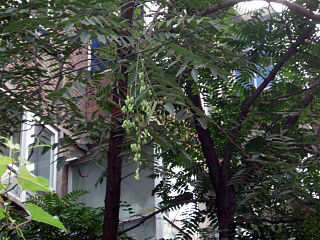
Toona sinensis, commonly called Chinese mahogany, Chinese cedar, Chinese toon, beef and onion plant, or red toon is a species of Toona native to eastern and southeastern Asia, from North Korea south through most of eastern, central and southwestern China to Nepal, northeastern India, Myanmar, Thailand, Malaysia, and western Indonesia.

Dalbergia sissoo, known commonly as North Indian rosewood, is a fast-growing, hardy deciduous rosewood tree native to the Indian subcontinent and southern Iran. D. Sissoo is a large, crooked tree with long, leathery leaves and whitish or pink flowers.

Setaria viridis is a species of grass known by many common names, including green foxtail, green bristlegrass, and wild foxtail millet. It is sometimes considered a subspecies of Setaria italica. It is native to Eurasia, but it is known on most continents as an introduced species and is closely related to Setaria faberi, a noxious weed. It is a hardy grass which grows in many types of urban, cultivated, and disturbed habitat, including vacant lots, sidewalks, railroads, lawns, and at the margins of fields. It is the wild antecedent of the crop foxtail millet.

Platypodium elegans or the graceful platypodium is a large leguminous tree found in the Neotropics that forms part of the forest canopy. It was first described by Julius Rudolph Theodor Vogel in 1837 and is the type species of the genus. The tree has been known to grow up to 30 metres in height and have a trunk with a diameter up to 1 m at breast height. Its trunk has large holes in it, sometimes making it possible to see through the trunk. The holes provide a habitat for giant damselflies and other insects both when alive and once the tree has died and fallen over. It has compound leaves each of which is made up of 10–20 leaflets. Three new chemical compounds have been isolated from the leaves and they form part of the diet of several monkeys and the squirrel Sciurus ingrami. In Panama it flowers from April to June, the flowers contain only four ovules, but normally only one of these reaches maturity forming a winged seed pod around 10 cm long and weighing 2 g. During the dry season around a year after the flowers are fertilised, the seeds are dispersed by the wind and the tree loses it leaves. The seeds are eaten by agoutis and by bruchid beetle larvae. The majority of seedlings are killed by damping off fungi in the first few months of growth, with seedlings that grow nearer the parent trees being more likely to die. The seedlings are relatively unable to survive in deep shade compared to other species in the same habitat. Various epiphytes are known to grow on P. elegans with the cactus Epiphyllum phyllanthus being the most abundant in Panama. Despite having holes in its trunk which should encourage debris and seeds to collect, hemiepiphytes are relatively uncommon, meaning that animals are not attracted to it to feed and then defecate. It has no known uses in traditional medicine and although it can be used for timber, the wood is of poor quality.
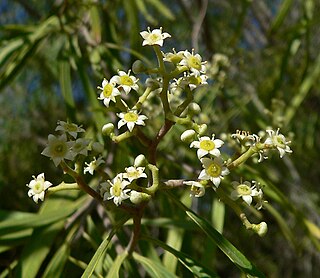
Geijera parviflora, commonly known as wilga, is a species of shrub or small tree in the family Rutaceae and is endemic to inland parts of eastern Australia. It has drooping branches, linear to narrow lance-shaped leaves, small white flowers in loose panicles and spherical fruit containing a shiny black seed. Other vernacular names include Australian willow, native willow, sheepbush and dogwood.

Xylomelum cunninghamianum is a species of flowering plant in the family Proteaceae and is endemic to eastern Australia. It is a shrub or small tree with narrow elliptic to lance-shaped leaves with toothed edges when young, groups of flowers covered with brownish hairs and oval fruit densely covered with velvety rust-coloured to grey hair.

Ficus altissima, commonly known as the council tree and lofty fig, is a species of flowering plant, a fig tree in the family Moraceae. It is a large, stately evergreen hemiepiphyte and is native to southeastern Asia.

Eucalyptus diptera, commonly known as the two-winged gimlet, is a mallet that is endemic to the south-west of Western Australia. It has smooth greenish to brownish bark, linear to lance-shaped adult leaves, flower buds in groups of three, each with two wings along the sides, creamy white to pale lemon-coloured flowers and cup-shaped to hemispherical fruit, also with two wings on the sides.
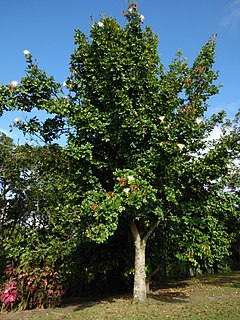
Pachira glabra is a tropical wetland tree in the mallow family Malvaceae, native to eastern Brazil, where it grows along rivers and other waterways. It is generally known by the nonscientific names Guinea peanut, French peanut, Saba nut, money tree, and lucky tree. It shares many of these common names with Pachira aquatica, the Malabar chestnut, which is quite similar looking, has similar culinary and ornamental uses, and is often confused with P. glabra.





















